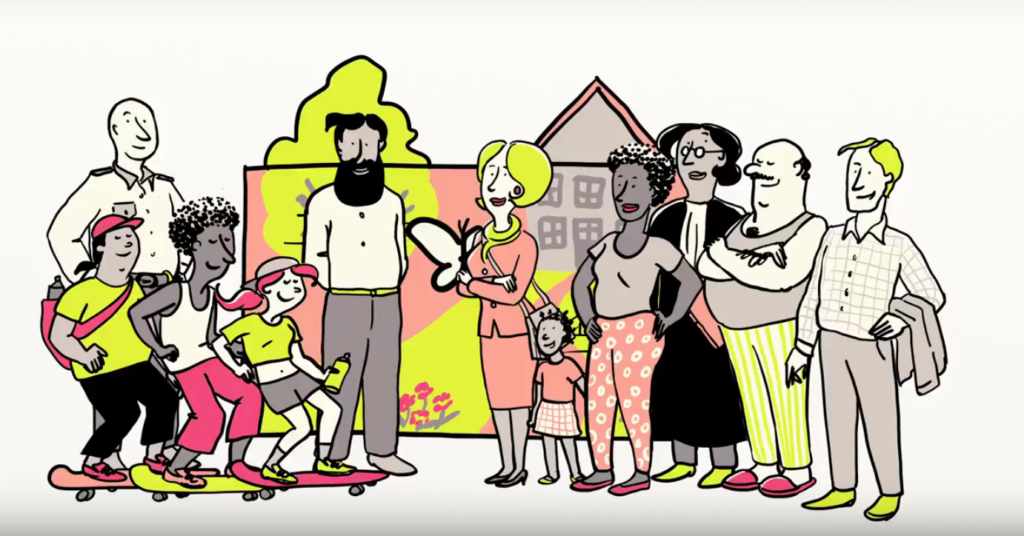Restorative Justice Animation & Resources
Can justice heal?
[The retributive justice system] is the most powerful stimulant of violence that we have yet discovered. ~ James Gilligan
Mass incarceration is one of the most painful issues in our society.
Clearly, we are approaching crime and how to deal with those who have committed a crime in the wrong way. No wonder people are getting interested in a different way altogether: Restorative Justice.
The indigenous people of New Zealand and other areas worldwide knew this; that instead of saying to offenders, “Hey get out of here” we should be saying “Hey, get in here.” Feeding our desire for revenge gets us nowhere; nor does meting out punishment. Restorative Justice is far better for the one involved in the crime, those immediately harmed by it, and the whole society that was torn, to that extent, by that wrong.
Punishment, however “just” it may seem, works by returning injury for injury. If the crime was a kind of violence – and in a sense it always is – so is the punishment. No wonder it isn’t working!
Restorative Justice embodies the principles of the exact opposite – nonviolence. No wonder it makes things better instead of worse.
Want to find out more? This animation is an introduction to the main principles; these pages list off some of the best resources available today – including practical tips for taking action!
Restorative Justice is an “upstream” solution that improves the whole social fabric and makes harmful behaviors less likely the more we practice it. We’re on the way to the future we all want!
Transcript here. Would you like to help us translate this? Email us.
Would you like to use this video for a presentation, training, or in an educational setting?
Please let us know so we can keep track and support you!
Got Facebook? Would you like to share this video on Facebook? Use this link and share directly from our Facebook Page where we’ve uploaded the video with more resources.
How can you contribute to bringing restorative practices to your community? Explore some key topics introduced in the video with these resources from the Metta Center and friends.
Restorative justice videos:
- Explore how restorative justice and nonviolence are related
- Explore a broader social perspective to why restorative justice can make positive impacts
- Explore how restorative practices fit in constructive programming
- Explore how restorative justice begins in our minds
Restorative justice theory and practice:
Restorative justice in social change and peace-building:
- Listen to Scott Brown’s experience with restorative justice
- Listen to Eli McCarthy from DC peace teams describe basics of restorative justice for peace team members
- and also listen to Mary Hanna talk about additional applications
Restorative justice in criminal justice systems:
- Explore restorative justice in prisons
- Explore restorative justice in criminal justice systems
- Restorative justice in action
Restorative justice in education:
- Watch a video about restorative justice in schools
- Learn more about restorative practices in schools
- Learn more about restorative justice in schools
Want to take action?
- Start with taking responsibility, repairing harms, and repairing relationships in your own life. One powerful way to start building a foundation to engage in this work is to start practicing nonviolent communication. This set of practices hones social, emotional, cognitive, and verbal skills that are foundational to practicing restorative justice and bringing about social change in your neighborhood.
- Spread the word about restorative justice. You can start using this animation and the materials on this page!
- Locate restorative justice efforts near you and get involved! There are of them and this heartening idea is spreading rapidly in schools and neighborhoods.
Do you like this video? Please donate to the Metta Center for Nonviolence. Your support will help us to share this message of nonviolence and its constructive uses with wider audiences.
Animator: Anabella Meijer; Scriptwriter: Rivera Sun; Voice: Stephanie Van Hook; Resource Collector: Joseph Gardella; Animations team: Michael Nagler, Maja Bengtson, James Phoenix, Frank Phoenix, and RJ friends. Special support to fund this project from the Fenwick Foundation.








